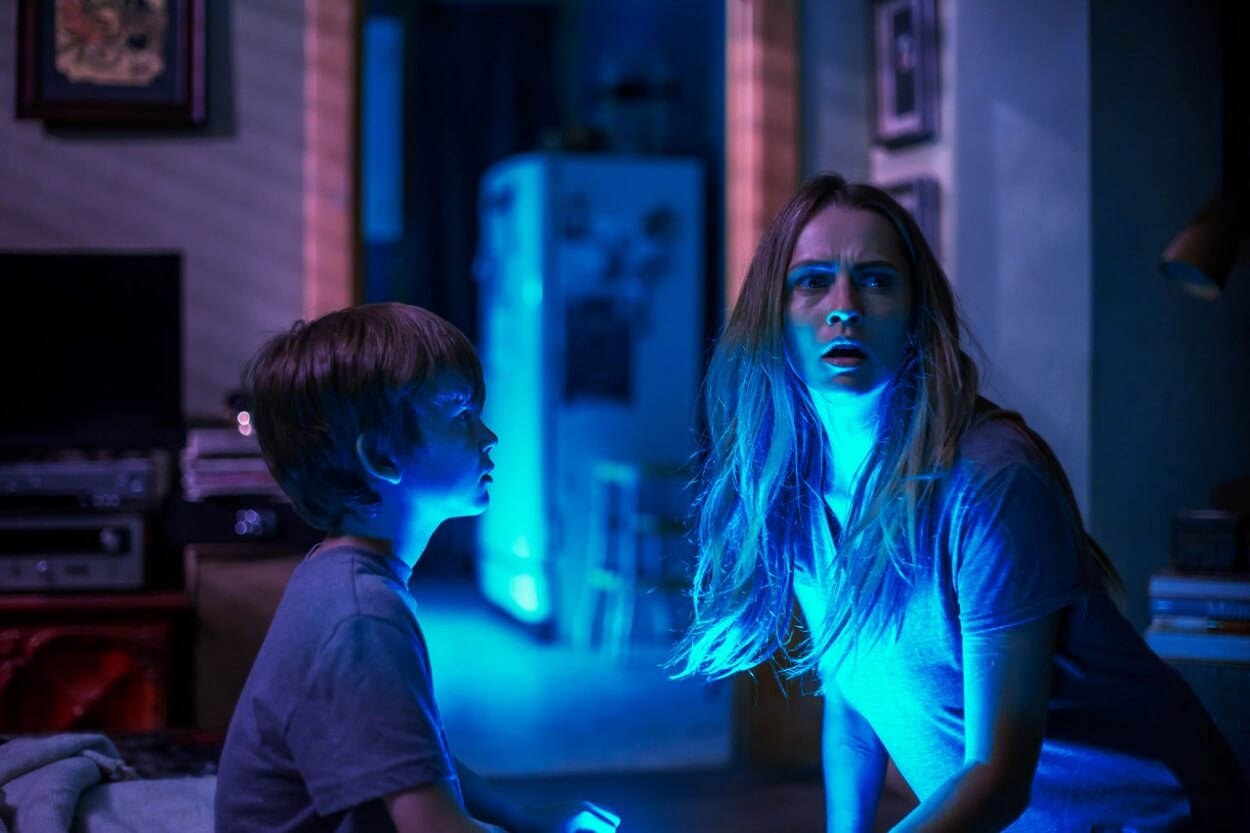Lights Out [2016] is the latest addition to the symbolic horror genre, following the nascent and still-fragile example of such titles as The Babadook and It Follows in the way it approaches its subject matter.
Every unhappy family is unhappy in its own way. In this case, the unhappiness stems from mom Sophie (Maria Bello)’s untreated mental illness, which is causing stress and heartache to her son even before the sudden death of her husband Paul (Billy Burke). Martin, the young son, is left alone with his mom, who spends every evening alone in her room having animated conversations with the darkness inside her closet. Soon, Sophie’s grown daughter Rebecca gets involved, worried for the welfare of her half-brother, but haunted by memories of her own time spent growing in that house, fearing the dark.
And the award for most luminous eyes goes to… Teresa Palmer, who plays Rebecca, is a glowing presence in the film, captivating the viewer whenever she appears onscreen. In a particularly creepy scene, she wakes in the light of a blinking tattoo parlor sign to find that something is getting closer and closer in the moments of darkness, only to become invisible in the light. Thanks to her compelling presence and performance, we are right there with her, riveted in terror. On the other end of the spectrum, I spent the first two-thirds of the film wondering who the vaguely Maria Bello-like actress was playing Sophie. Bello doesn’t resemble her usual self – instead, she is beaten and a little vacant. It’s an interesting choice, and accurate in its portrayal of someone with depression, but it doesn’t make for compelling viewing.
Unbelievable amounts of darkness. While it’s understandable that a movie about a creature that lives in the dark would be, well, dark, the scenes in which characters are turning on lights in order to ward off the darkness are peculiar and sort of silly. There is no contrast of dark to light - instead, we get dark and darkish. These characters seem to live in an alternate reality where a full range of light bulbs is unavailable and candlelight is sometimes the brightest thing in a room with a couple of lamps! Instead of adding to the atmosphere, the effect is distracting, as viewers are familiar with the practicalities of nighttime and household lighting. No one’s house is that dark, and while in a more subtle way this effect could support the mood of the film, it is in actuality so extreme that it becomes a bit ridiculous.
Plenty of tension. Despite these nitpicks, the film’s horror elements are very enjoyable, with several creepy sequences. I am a big fan of suspense and of monsters we can’t quite see, and Lights Out delivers on both of these elements. It sets up the rules of its antagonist’s existence right from the start and uses them to maximum effect throughout the film. When we see her, we aren’t sure what we’re seeing, except that it’s uncanny and wrong. Even the most seasoned horror viewer is sure to feel his or her flesh crawl at some point in this film. And for lovers of jump scares, rest assured that there are a few of those waiting in here for you – and they are all well-earned, and not kitty-cats jumping from the tops of filing cabinets.
Thematic issues. It is hard to go too much into detail on the theme of this film and whether it was successful in realizing what it set out to do without spoiling the entire thing. Suffice it to say that while it seems evident to me that Lights Out is an attempt by Writer/Director David F. Sandberg and Writer Eric Heisserer to contribute to the canon of what I will call the New Symbolic Horror subgenre, it doesn’t quite fit in for a couple of reasons. The first is the compulsion to include too specific a backstory for its horror movie monster, which we understand to be intrinsically linked to Sophie’s depression (the worse Sophie’s illness gets, the more present the creature, while during periods of successful treatment the antagonist virtually disappeared). The second thing that makes Lights Out feel like a tribute to The Babadook rather than a direct contribution to the subgenre is its very ending, which fails to recognize what those other films did so well. Commonly, the demons in New Symbolic Horror can’t be bested, they can only be acknowledged and endured, and maybe stayed for a time. Lights Out misunderstands the importance of a cohesive ending, and somehow the result is both more and less bleak than one would expect from the subgenre.
Lights Out is a creepy and tense horror film in the tradition of The Babadook, but with a thematically shaky foundation.

